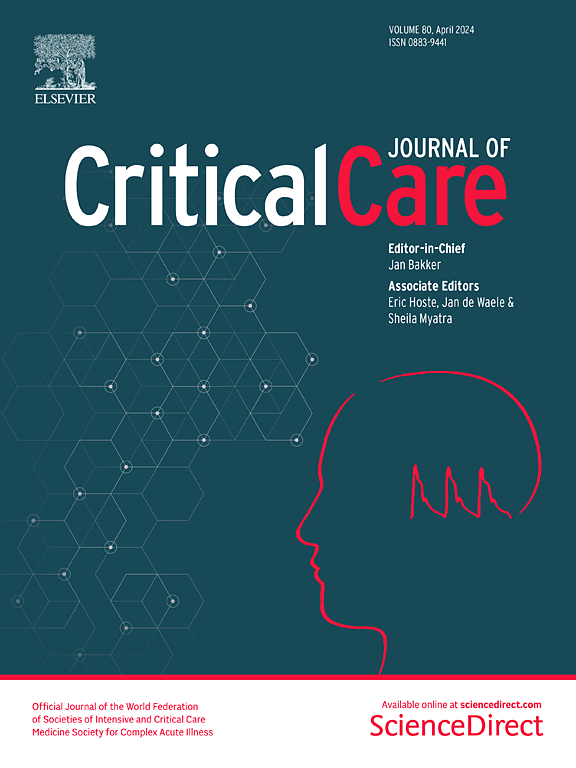败血症中皮质醇的新轨迹亚型
IF 9.3
1区 医学
Q1 CRITICAL CARE MEDICINE
引用次数: 0
摘要
败血症是一种异质性综合征。本研究旨在利用血浆皮质醇的变化轨迹来识别新的败血症亚型。这项回顾性研究纳入了2020年3月至2022年7月期间入住复旦大学附属中山医院重症监护室的败血症患者。研究采用基于组皮质醇轨迹的模型将脓毒症患者分为不同的亚型。比较了不同亚型的临床特征、生物标志物和预后。研究共纳入了 258 名脓毒症患者,其中 186 人为男性。患者被分为两组:低皮质醇组(217 人)的皮质醇水平持续较低且缓慢下降,而高皮质醇组(41 人)的皮质醇水平相对较高。高皮质醇组的 28 天死亡率(65.9% 对 16.1%,P < 0.001)和 90 天死亡率(65.9% 对 19.8%,P < 0.001)明显高于低皮质醇组。多变量 Cox 回归分析显示,轨迹亚表型(HR = 5.292; 95% CI 2.218-12.626; P < 0.001)、APACHE II(HR = 1.109; 95% CI 1.030-1.193; P = 0.006)、SOFA(HR = 1.161; 95% CI 1.045-1.291; P = 0.006)和IL-1β(HR = 1.001; 95% CI 1.000-1.002; P = 0.007)是28天死亡率的独立危险因素。此外,轨迹亚表型(HR = 4.571; 95% CI 1.980-10.551; P < 0.001)、APACHE II(HR = 1.108; 95% CI 1.043-1.177; P = 0.001)、SOFA(HR = 1.270; 95% CI 1.130-1.428; P < 0.001)和IL-1β(HR = 1.001; 95% CI 1.000-1.001; P = 0.015)也是90天死亡率的独立危险因素。本研究在脓毒症患者中发现了两种新的皮质醇轨迹亚型。这些轨迹与死亡率相关,为脓毒症分类提供了新的见解。本文章由计算机程序翻译,如有差异,请以英文原文为准。
Novel cortisol trajectory sub-phenotypes in sepsis
Sepsis is a heterogeneous syndrome. This study aimed to identify new sepsis sub-phenotypes using plasma cortisol trajectory. This retrospective study included patients with sepsis admitted to the intensive care unit of Zhongshan Hospital Fudan University between March 2020 and July 2022. A group-based cortisol trajectory model was used to classify septic patients into different sub-phenotypes. The clinical characteristics, biomarkers, and outcomes were compared between sub-phenotypes. A total of 258 patients with sepsis were included, of whom 186 were male. Patients were divided into two trajectory groups: the lower-cortisol group (n = 217) exhibited consistently low and slowly declining cortisol levels, while the higher-cortisol group (n = 41) showed relatively higher levels in comparison. The 28-day mortality (65.9% vs.16.1%, P < 0.001) and 90-day mortality (65.9% vs. 19.8%, P < 0.001) of the higher-cortisol group were significantly higher than the lower-cortisol group. Multivariable Cox regression analysis showed that the trajectory sub-phenotype (HR = 5.292; 95% CI 2.218–12.626; P < 0.001), APACHE II (HR = 1.109; 95% CI 1.030–1.193; P = 0.006), SOFA (HR = 1.161; 95% CI 1.045–1.291; P = 0.006), and IL-1β (HR = 1.001; 95% CI 1.000–1.002; P = 0.007) were independent risk factors for 28-day mortality. Besides, the trajectory sub-phenotype (HR = 4.571; 95% CI 1.980–10.551; P < 0.001), APACHE II (HR = 1.108; 95% CI 1.043–1.177; P = 0.001), SOFA (HR = 1.270; 95% CI 1.130–1.428; P < 0.001), and IL-1β (HR = 1.001; 95% CI 1.000–1.001; P = 0.015) were also independent risk factors for 90-day mortality. This study identified two novel cortisol trajectory sub-phenotypes in patients with sepsis. The trajectories were associated with mortality, providing new insights into sepsis classification.
求助全文
通过发布文献求助,成功后即可免费获取论文全文。
去求助
来源期刊

Critical Care
医学-危重病医学
CiteScore
20.60
自引率
3.30%
发文量
348
审稿时长
1.5 months
期刊介绍:
Critical Care is an esteemed international medical journal that undergoes a rigorous peer-review process to maintain its high quality standards. Its primary objective is to enhance the healthcare services offered to critically ill patients. To achieve this, the journal focuses on gathering, exchanging, disseminating, and endorsing evidence-based information that is highly relevant to intensivists. By doing so, Critical Care seeks to provide a thorough and inclusive examination of the intensive care field.
 求助内容:
求助内容: 应助结果提醒方式:
应助结果提醒方式:


